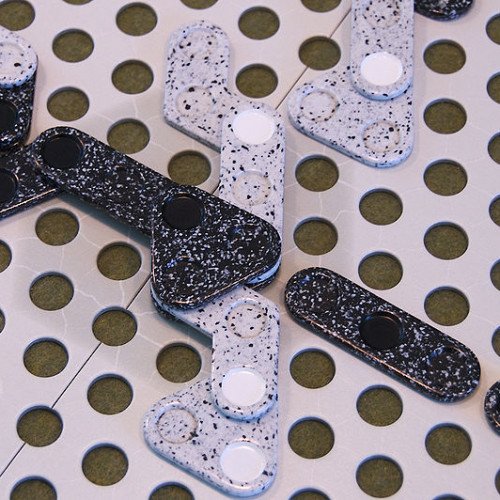PÜNCT VS SUFFRAGETTO

PÜNCT
PÜNCT is a two-player strategy board game. It is the sixth (and final) release in the GIPF project of six abstract strategy games, although it is considered the fifth game in the project. It was released in 2005. PÜNCT won the Games Magazine Best Abstract Strategy game for 2007. The PÜNCT board game is one of six games a part of the GIPF project. This project was created by Kris Burm and is a series of six abstract games. PÜNCT is the 5th game of the project and the board of this game is shaped like a hexagon. This game was released in 2005.[citation needed] PÜNCT is a two-player connection game. The objective is to connect two sides of a hexagonal board, using pieces which cover three hexes each. The pieces can be placed, moved, rotated, and stacked in various ways, restricted by the geometry of the board, the shape of the pieces, and gravity. Players can bring new pieces to the board or can attempt to connect the pieces already in play. The objective of the game is to mislead the opponent. When the players take their first turn, they are not able to use the central hexagon. The PÜNCT piece is used as a point of reference throughout the game, but the PÜNCT piece can't be moved when the player is making a move. Minor dots can land on the other player's piece, but the PÜNCT piece may not. In order to make a move, three dots must be in perfect alignment. The pieces that are on top of all of the other pieces have the most power in this game. The dots on the ends of the pieces must be at the same level horizontally to play this game correctly. In order to make a bridge in this game, you must perform a jump move on a piece already on the board. The positions of the dots at the end don't have to be aligned with the middle or stable horizontally. When determining the winner, a player can lift one piece at a time to determine if a connection was made. To connect opposite sides in this game, players can move pieces on top of other pieces or they can stack pieces to block the opponent's connection, ergo, making a connection for themselves. The actual PÜNCT piece, which is a rounded piece that has one point, cannot be used to make a connection or form a “chain” but rather used as a point of reference.
Statistics for this Xoptio

SUFFRAGETTO
Suffragetto was a board game published in the United Kingdom around 1908 by the Women's Social and Political Union (WSPU) and manufactured by Sargeant Bros. Ltd. In modern terms, it was developed to "enact feminist ideology in a hybrid fantasy-real world environment" to support the activist strategies of the suffragettes. The game is a contest of occupation featuring two players around a grid board representing the streets of Edwardian London. One player plays 21 green markers as the radical suffragettes, the other player plays 21 dark blue markers as the police constables. The objective of the suffragettes is to break through police lines and enter the House of Commons, while at the same time preventing the police from entering Albert Hall. The objective of the police is to disrupt the meeting of the suffragettes by entering Albert Hall, while at the same time preventing them from entering the House of Commons. "Arrested" suffragettes are confined to the "prison" section of the board, whereas "disabled" constables are confined to the "hospital" section. The game is won by the first player who introduces six markers into the opponent's base. The WSPU were enthusiastic about manufacturing and selling the game, as it would allow the organisation to continue running without having to depend on donations from wealthy individuals. Oxford's Bodleian Libraries has the only known surviving copy of the game. Suffragetto was among several children's games designed at that time around the themes of gender, resistance, and social relationships, along with the contemporaneous games Panko and Pank-a-Squith (1909). The goal of the latter was to navigate a suffragette (led by Emmeline Pankhurst) down a long path from her home to parliament, past obstacles placed by the Liberal government (led by Prime Minister H. H. Asquith).